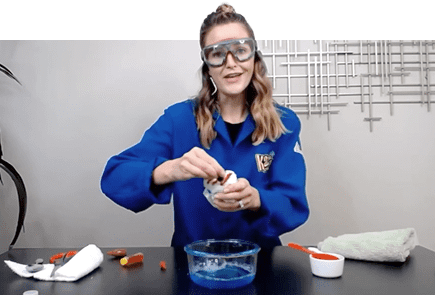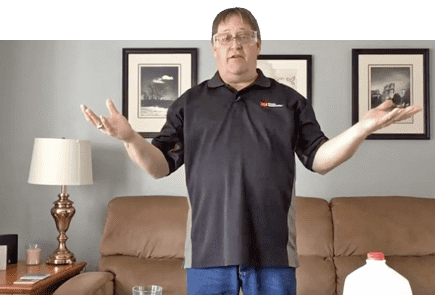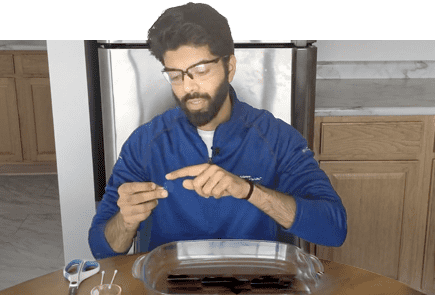Your teacher might not love them in class, but the physics behind fidget spinners are truly head-spinning! Join 3M scientist Tesha R.-Alston Dampier as she shows you how a spinning motion changes the way things move.
Background
Fidget spinners work due to their unique design: three weights spin in unison around a central bearing. The rapid movement of the weights combined with gravitational forces create the sensation of weight when manipulating the spinning toy. Today we are going to examine some of the fascinating science behind fidget spinners. Sure, they spin, but why do they spin so smoothly, and for so long? Why is it difficult to flip one over mid-spin? Let’s try to answer these questions with an experiment.
Key Concepts
- Force
- Motion
Materials
- An adult helper
- Fidget spinner
- Pencil or chopstick
- 12 inches of string
- Tape
Preparation
- Tie a loop in one end of the string.
- Tape the other end of the string to a shelf or table, so the loop is dangling free.
- Put the pencil or chopstick through the middle hole of the fidget spinner so there is only about 1 inch from the fidget spinner to the end of the pencil or chopstick.
- Make a prediction. What will happen when the pencil is only supported by the string on one side?
- Spin the fidget spinner so it is going fast.
- Put the short end of the pencil or chopstick into the loop of string, being careful not to tangle the string in the fidget spinner.
- Let the pencil or chopstick go and see what happens.
- Be sure to clean up when you are all done. Throw the tape away and put the other materials back where you found them.
Observation and Results
The pencil should stay balanced parallel to the ground and spin around in a circle. If that doesn’t happen, try spinning the fidget spinner the opposite direction and try again. This happens because of the way that a spinning object changes the way that forces act on it. This is called gyroscopic precession and happens when a spinning object is suspended on an axle. The torque or rotational force of the fidget spinner is pushing outward from the axle, in this case a pencil or chopstick, which allows it to stay suspended and turn slowly in a circle. Gyroscopic precession is what allows a bike to stay upright while it’s moving, and why you have to put your foot down to balance when you stop.
The way fidget spinners are built makes them great for this experiment, but that doesn't mean they are our only option. For example, bikes were mentioned, and if you have a bike wheel available, maybe you could find a way to set this up with a string or rope and a bike wheel in a garage or outside. What else can you find that you could easily spin on some kind of axle like a pencil, a chopstick, or a stick?
We suggested about an inch between the fidget spinner and the string, but what happens if you use more or less distance? If you find some distances that don't work, can you figure out or research why they don't? If you're spinning other objects, what distances work for those specific objects, and why might they be different than, or the same as the distance for a fidget spinner?
Lastly, what happens if the string is moving? Does it change the behavior of the spinning object? Does the way the string is moving make a difference? Remember to be aware of where you’re doing the experiment and what’s around you!
Safety First and Adult Supervision
- Follow the experiment’s instructions carefully.
- A responsible adult should assist with each experiment.
- While science experiments at home are exciting ways to learn about science hands-on, please note that some may require participants to take extra safety precautions and/or make a mess.
- Adults should handle or assist with potentially harmful materials or sharp objects.
- Adult should review each experiment and determine what the appropriate age is for the student’s participation in each activity before conducting any experiment.
Next Generation Science Standard (NGSS) Supported - Disciplinary Core Ideas
This experiment was selected for Science at Home because it teaches NGSS Disciplinary Core Ideas, which have broad importance within or across multiple science or engineering disciplines.
Learn more about how this experiment is based in NGSS Disciplinary Core Ideas.
Engineering Design (ETS)1: Engineering Design
Grades K-2
- K-PS1-1. Pushes and pulls can have different strengths and directions.
- K-PS1-2. Pushing or pulling on an object can change the speed or direction of its motion and can start or stop it.
Grades 3-5
- 3-PS1-1. Each force acts on one particular object and has both strength and a direction.
- 3-PS1-2. The patterns of an object’s motion in various situations can be observed and measured: when that past motion exhibits a regular patter, future motion can be predicted from it.
Grades 6-8
- MS-PS1-2. The motion of an object is determined by the sum of the forces acting on it; if the total force on the object is not zero, its motion will change. The greater the mass of the object, the greater the force needed to achieve the same change in motion.
Grades 9-12
- HS-PS1-1. Newton's second law accurately predicts changes in the motion of macroscopic objects.
Grades K-2
- K-PS2-1. When objects touch or collide, they push on one another and can change motion.
Grades 3-5
- 3-PS2-1. Objects in contact exert forces on each other.
- 3-PS2-1. The gravitational force of Earth acting on an object near Earth’s surface pulls that object toward the planet’s center.
Grades 3-5
- 4-PS3-1. The faster a given object is moving, the more energy it possesses.
Grades 6-8
- MS-PS3-1. Motion energy is properly called kinetic energy; it is proportional to the mass of the moving object and grows with the square of its speed.
- MS-PS3-2. A system of objects may also contain stored (potential) energy, depending on their relative positions.
Grades 9-12
- HS-PS3-1. Energy is a quantitative property of a system that depends on the motion and interactions of matter and radiation within that system.
- HS-PS3-3. At the macroscopic scale, energy manifests itself in multiple ways, such as in motion.
Grades 3-5
- 4-PS3-2. Energy is present whenever there are moving objects.
Grades 6-8
- MS-PS3-5. When the motion energy of an object changes, there is inevitably some other change in energy at the same time.
Grades 9-12
- HS-PS3-1. Conservation of energy means that the total change of energy in any system is always equal to the total energy transferred into or out of the system.
- HS-PS3-4. Uncontrolled systems always evolve toward more stable states.
Grades K-2
- K-PS3-1. A bigger push or pull makes things go faster.
Grades 3-5
- 4-PS3-3. When objects collide, the contact forces transfer energy so as to change the objects' motions.
Grades 6-8
- MS-PS3-2. When two objects interact, each one exerts a force on the other that can cause energy to be transferred to or from the object.
Grades 3-5
- 4-PS3-4. The expression "produce energy" typically refers to the conversion of stored energy into a desired form for practical use.
Grades 9-12
- HS-PS3-3. Although energy cannot be destroyed, it can be converted to less useful forms.
Explore Additional Science at Home Videos and Activities

Rainbow Bubble Snake
Everyone loves bubbles, but have you ever thought about how they form?
In this video, special guest, Kate the Chemist, shows you the science behind bubbles. With just a few simple materials, you’ll learn how to make a bright and colorful bubble snake using your breath, soap, water and a plastic water bottle.

Liquid Fireworks
Join 3M scientist Jeff Payne as he uses nothing more than milk, dish soap, and a few other kitchen supplies to get the amazing effects of fireworks without using any fire at all.

Soap Boat
Join 3M Researcher Vasav Shani as he introduces you to the science of surface tension.
Not only is it only important for many engineering and earth science processes, it also makes blowing bubbles possible.

